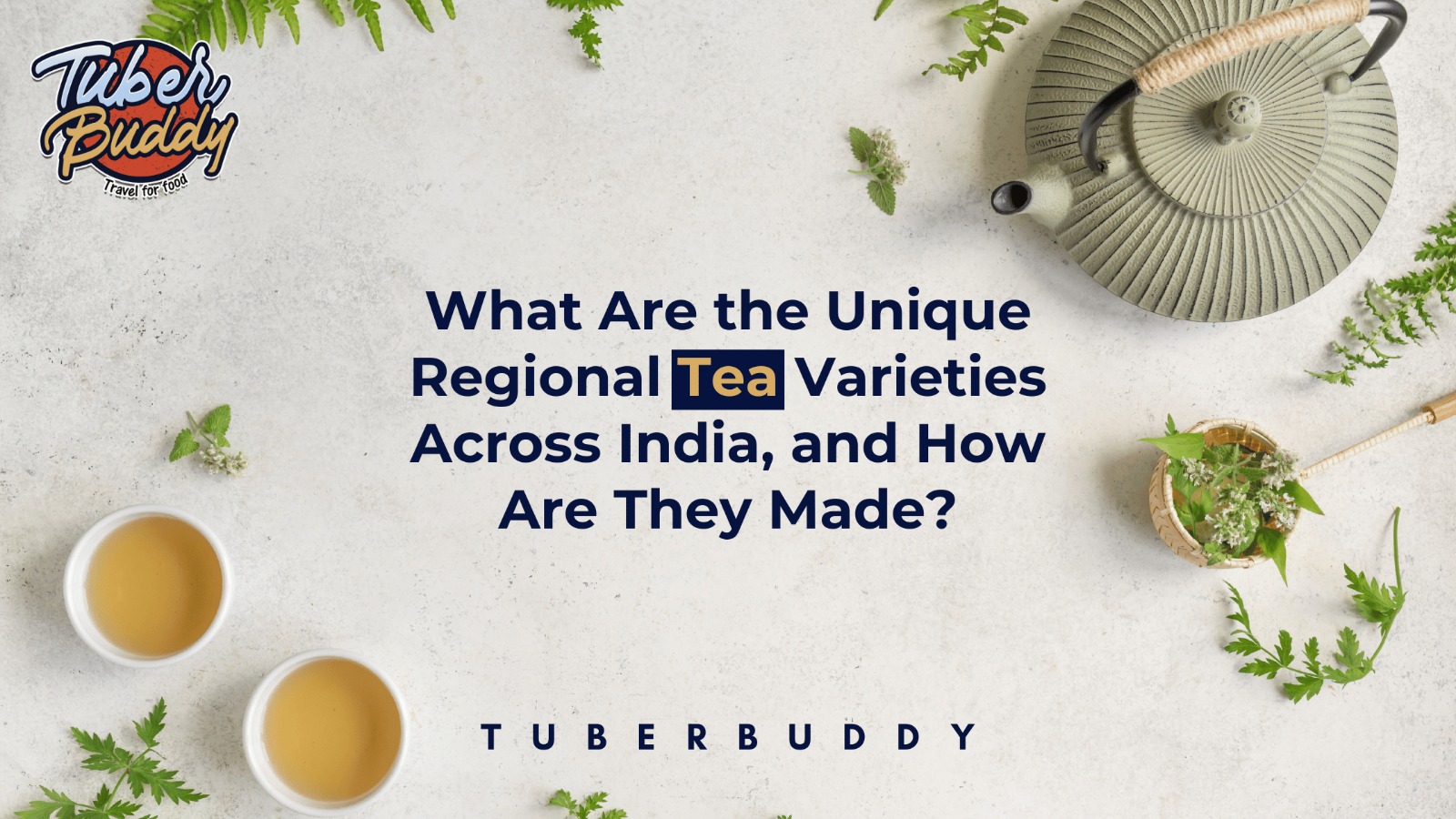Masala Chai Recipe | How to Make Authentic Indian Spiced Tea

India is one of the world’s largest tea producers, with each region offering unique flavors, aromas, and brewing traditions. From the famed Assam and Darjeeling teas to lesser-known varieties like Sikkim’s Temi tea, Indian teas provide a rich sensory experience. Among these, spiced tea holds a special place in Indian households, and trying a traditional Masala Chai Recipe is one of the best ways to experience the warmth and authenticity of Indian tea culture. Here’s a journey through India’s unique regional teas and how they are made.
1. Assam Tea
Region: Assam
Flavor Profile: Bold, malty, and strongAssam, with its lush tea gardens, produces nearly half of India’s tea. Known for its robust, malty flavor, Assam tea is often used in breakfast blends like English Breakfast. The tea leaves are rolled and oxidized, giving Assam tea its deep, reddish-brown color and strength. It is best enjoyed with milk and sugar, making it a popular base for chai.
Brewing Tip: Steep for 3-5 minutes in boiling water for a strong, malty flavor.
2. Darjeeling Tea
Region: West Bengal (Darjeeling)
Flavor Profile: Floral, light, and muscatelOften called the “Champagne of Teas,” Darjeeling tea is known for its delicate floral aroma and subtle fruity notes. Grown on the slopes of the Himalayas, it has a unique “muscatel” flavor—a sweet and fruity taste similar to muscat grapes. Unlike other Indian teas, Darjeeling is usually made as a light brew without milk.
Brewing Tip: Use slightly cooler water (85-90°C) and steep for 2-3 minutes to preserve its delicate flavor.
3. Nilgiri Tea
Region: Tamil Nadu (Nilgiri Hills)
Flavor Profile: Fragrant, brisk, and smoothNilgiri tea, grown in the hills of southern India, has a fragrant, brisk taste with a hint of fruitiness. Its high-altitude plantations produce leaves that yield a rich amber liquor and a smooth flavor, making it a popular choice for iced teas. Nilgiri tea is versatile and can be enjoyed with or without milk.
Brewing Tip: Steep in hot water for 3-4 minutes for a balanced and smooth flavor.
4. Kangra Tea
Region: Himachal Pradesh (Kangra Valley)
Flavor Profile: Mild, vegetal, and slightly smokyKangra tea, grown in Himachal Pradesh’s Kangra Valley, has a unique flavor profile characterized by a mild vegetal taste with smoky undertones. Known for its health benefits, Kangra green tea is light and refreshing, while the black tea variant has a distinct aroma. This tea is often enjoyed without milk to fully appreciate its nuanced flavor.
Brewing Tip: Use hot but not boiling water (around 85-90°C) for 2-3 minutes for green tea and boiling water for black tea.
5. Kashmiri Kahwa
Region: Jammu and Kashmir
Flavor Profile: Aromatic, warm, and spicyKahwa is a traditional Kashmiri green tea brewed with spices like cardamom, cinnamon, and saffron, giving it a warm and aromatic flavor. Often garnished with crushed almonds or walnuts, this tea is soothing, especially in colder months. Kahwa is made in a samovar (a traditional kettle) and does not include milk.
Brewing Tip: Boil water with the spices, add green tea leaves, and simmer for a few minutes. Garnish with nuts for an authentic experience.
6. Butter Tea (Po Cha)
Region: Ladakh and Sikkim
Flavor Profile: Creamy, salty, and richButter tea, also known as Po Cha, is popular in the Himalayan regions of Ladakh and Sikkim. Made with tea leaves, yak butter, and salt, it has a unique salty taste and creamy texture. This tea is traditionally brewed and churned to emulsify the butter, providing warmth and sustenance in high altitudes.
Brewing Tip: Simmer black tea leaves for a few hours, then add butter and salt, and churn until creamy.
7. Sikkim Temi Tea
Region: Sikkim
Flavor Profile: Floral, smooth, and mellowTemi tea, grown in Sikkim’s only tea garden, Temi Tea Estate, has a smooth and mellow flavor with mild floral notes. This tea, similar to Darjeeling, is delicate yet flavorful and is enjoyed without milk. Sikkim’s clean air and high-altitude environment contribute to the tea’s quality.
Brewing Tip: Use hot but not boiling water, and steep for 2-3 minutes to retain its mild, floral flavors.
8. Munnar Tea
Region: Kerala (Munnar)
Flavor Profile: Refreshing, earthy, and brightGrown in the Western Ghats of Kerala, Munnar tea is known for its bright, refreshing taste and earthy aroma. With scenic tea gardens, Munnar produces mostly black tea, and its leaves are prized for their clean, bold flavor. It’s best enjoyed plain or with a dash of lemon.
Brewing Tip: Steep for 3-5 minutes for a bright and robust flavor.
9. Goan Chai
Region: Goa
Flavor Profile: Sweet, spicy, and creamyGoan chai is unique for its strong, sweet flavor and thick consistency. This local tea, influenced by Goan and Portuguese traditions, is boiled with milk, sugar, and spices like ginger and cardamom. Served in small cups, Goan chai is perfect for a midday refreshment.
Brewing Tip: Simmer tea leaves with milk, sugar, and spices for a strong and aromatic flavor.
10. Bombay Cutting Chai
Region: Mumbai (Maharashtra)
Flavor Profile: Strong, spicy, and aromaticPopular in Mumbai, cutting chai is a small, strong cup of spiced tea served in half portions. Made with a mix of black tea leaves, milk, sugar, and spices, it is often sold in small glasses by street vendors. Cutting chai is an energizing blend enjoyed on the go, capturing the hustle of city life.
Brewing Tip: Boil tea leaves, milk, and spices together for a few minutes to achieve a strong, bold flavor.
FAQs
1. What is the most popular type of tea in India?
Assam and Darjeeling teas are the most popular, widely consumed across India for their distinctive flavors.2. Can all Indian teas be enjoyed without milk?
Yes, many regional teas like Darjeeling, Kangra, and Temi are enjoyed without milk, especially to preserve their delicate flavors.3. What is the healthiest regional tea?
Kangra green tea and Kashmiri Kahwa are considered healthy for their antioxidant properties and are often enjoyed without milk or sugar.For more on India’s traditional beverages, visit our recent blog on Indian Street Foods at Tuber Buddy.
Each cup of regional tea in India is a sip of culture and history—so explore, savor, and enjoy the diversity!



